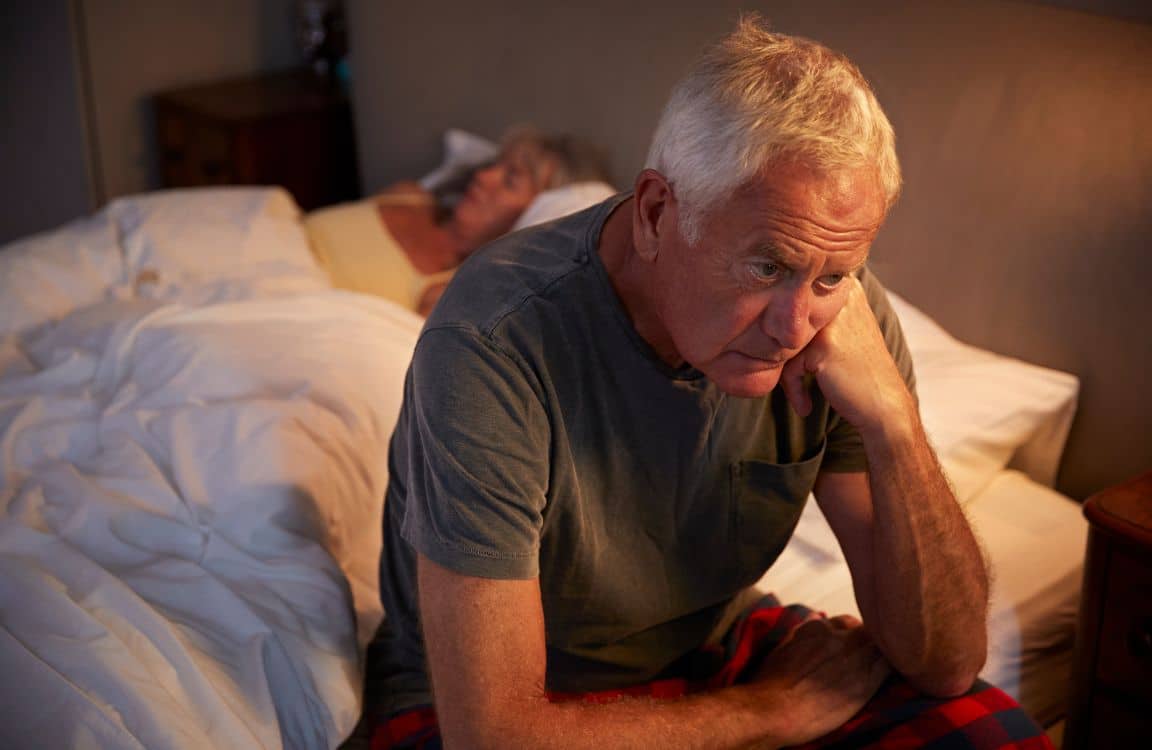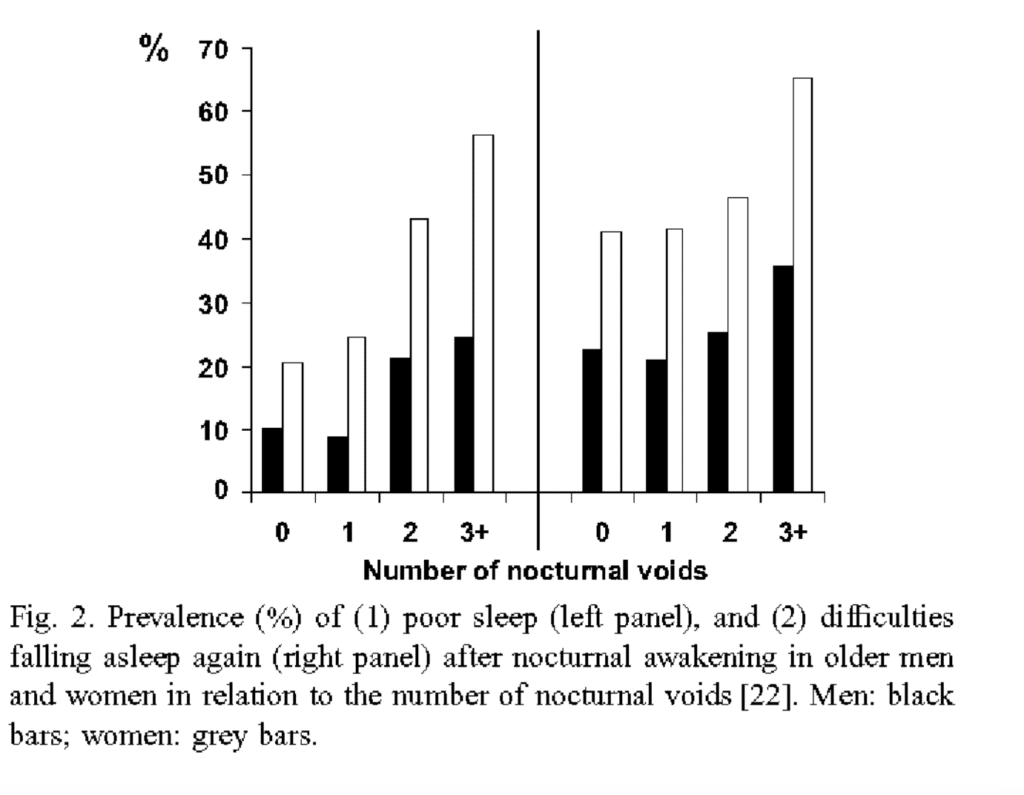
Nocturia and the Aging Athlete: Are Nighttime Bathroom Trips Wrecking Your Training?
By Jim Rutberg,
CTS Pro Coach,
co-author of “The Time-Crunched Cyclist”,
“Training Essentials for Ultrarunning”, and “Ride Inside“
If you wake up two or more times at night to urinate, it is likely that your training – and other aspects of your daily life – are being negatively affected. Here’s what you can do about it.
What is Nocturia?
Nocturia, which is the need to wake up to urinate during a sleep period, can have multiple causes. Some are fixable with behavior changes, others may respond to medication, and you may just have to work around a few. Active individuals generally experience fewer incidences of nocturia compared to sedentary age-matched peers. However, for aging athletes, waking up to pee can disturb your sleep to the point it hinders your post-workout recovery, your readiness for today’s training, and your long-term adaptation to training.
Prevalence of Nocturia
Although waking up to pee is often thought of as an aging male problem, the prevalence of nocturia is even higher for females! A 2020 study reported the prevalence of nocturia among a total of 24,800 males and females ranging from 20 to 60+ years old (Soysal et al. 2019). First, they looked at the prevalence of waking up at least once at night to urinate. The data are listed in the table below. Next, they reported the prevalence of waking up two or more times at night to urinate. Unsurprisingly, they found an association between increased age and increased incidence of nocturia. It is notable that more than 70% of adults over 40 wake up at least once per night to urinate, and nearly half of adults over 60 wake up at least twice nightly to urinate!

adapted from Soysal 2019
Common causes of Nocturia
Many factors contribute to the development of nocturia, which is why there is no easy fix. Some common causes and factors include:
- Age (see above)
- Polyuria: body produces too much urine in a 24-hour period
- Nocturnal polyuria: body produces more than 33% of 24-hour urine volume at night.
- Bladder issues: overactive bladder or bladder that doesn’t store urine well
- Diabetes: frequent urination to eliminate sugar
- High blood pressure: increased urine production to reduce BP
- Benign prostate hyperplasia: enlarged prostate
- Drinking too much fluid before bedtime
- Diuretic medications like those taken for hypertension and congestive heart failure
Among the population of endurance athletes our coaches work with, the most common causes for nocturia seem to be, anecdotally, age (male and female), enlarged prostate (male), and drinking too much fluid before bedtime.
Nocturia and athletic performance
Athletes over 50 – and certainly over 60 – are redefining the science of healthy aging. As a result, there isn’t much research available that directly examines the effect of nocturia on athletic performance in aging athletes. However, we can draw some reasonable conclusions from adjacent research. For instance, there is plenty of evidence to show that multiple nights of disturbed sleep negatively affect workout quality, hinders post-workout recovery, and slows or halts positive adaptation to training stress (Hamlin et al. 2021). Another study reported data from 92,000 subjects that showed increased incidences of nocturia were progressively more detrimental to workplace engagement, productivity, and subjective wellbeing (Hafner et al. 2020). This supported earlier research from 2005 (figure below) that showed an association between the number of nighttime trips to the bathroom and both poor sleep and trouble going back to sleep (Asplund 2005).
In aging and elderly populations, nocturia is associated with increased risk of falls and fractures, reduced daytime cognitive function, immunosuppression, and lower quality of life. Taken together, it seems reasonable to expect that aging athletes who wake up multiple times per night to urinate would experience performance deficits due to disturbed sleep.
What athletes can do to treat nocturia
Can an aging athlete’s fitness counteract the negative effects of nighttime trips to the bathroom? To some extent, yes. Exercising, improving cardiovascular fitness, and losing weight are common recommendations provided to sedentary individuals experiencing nocturia. This makes sense because exercise interventions can reduce the severity of hypertension, cardiac symptoms, and Type 2 diabetes – all of which increase urine production. But what if you’re already fit and relatively lean?
Medications for nocturia
For males, benign prostate hyperplasia (enlarged prostate, not caused by prostate cancer) is a major cause for frequent urination, the frequent urge to urinate, difficulty going, and difficulty stopping. Athletes diagnosed with an enlarged prostate may be prescribed group of medications called alpha blockers, which includes Terazosin (Hytrin), Doxazosin (Cardura), and Tamsulosin (Flomax). In some instances, your urologist may recommend a number of surgical options that remove varying amounts of prostate tissue.
Doctors may recommend medications that reduce urine production for both male and female athletes experiencing nocturia. Desmopressin is a drug that acts similarly to vasopressin, an antidiuretic hormone your body produces to limit fluid loss.
► Free Cycling Training Assessment Quiz
Take our free 2-minute quiz to discover how effective your training is and get recommendations for how you can improve.
If you are taking diuretics for another medical problem (like hypertension or Type 2 diabetes), ask your physician about taking them earlier before bedtime.
Exercises and behavior changes for mitigating nocturia
Pelvic floor exercises – Kegels – can strengthen pelvic muscles, which helps suppress bladder contractions and reduce the feeling that you need to urinate right away. These are important exercises for both male and female athletes.
From a behavior standpoint, schedule your post-workout fluid replenishment so you can stop drinking sooner before bedtime. This will take some trial and error, as you must strike a balance between staying hydrated and taking multiple trips to the bathroom during the night.
Even if you are not able to eliminate nighttime bathroom trips entirely, aim for an increase in “hours of undisturbed sleep”. Your sleep quality (and training quality!) will improve if a combination of the behaviors, medications, and exercises above results in a longer initial period of undisturbed sleep, and hopefully fewer total wakeups.
References
Asplund, R. Nocturia: consequences for sleep and daytime activities and associated risks. European Urology Supplements, 3(6), (2005): 24–32. doi:10.1016/s1569-9056(05)80004-1
Bosch, J L H Ruud, and Jeffrey P Weiss. “The prevalence and causes of nocturia.” The Journal of urology vol. 184,2 (2010): 440-6. doi:10.1016/j.juro.2010.04.011
Hafner, Marco et al. “Assessing the burden of nocturia in the workplace: the associations between nocturnal voiding, subjective well-being, work engagement and productivity.” Journal of medical economics vol. 23,9 (2020): 994-1003. doi:10.1080/13696998.2020.1767631
Hamlin, Michael J et al. “The Effect of Sleep Quality and Quantity on Athlete’s Health and Perceived Training Quality.” Frontiers in sports and active living vol. 3 705650. 10 Sep. 2021, doi:10.3389/fspor.2021.705650
Soysal, Pinar et al. “Trends and prevalence of nocturia among US adults, 2005-2016.” International urology and nephrology vol. 52,5 (2019): 805-813. doi:10.1007/s11255-019-02361-5
Weiss, Jeffrey P, and Karel Everaert. “Management of Nocturia and Nocturnal Polyuria.” Urology vol. 133S (2019): 24-33. doi:10.1016/j.urology.2019.09.022
► FREE Mini-Course: Learn How to Maximize Your Limited Training Time
Learn step-by-step how to overcome limited training time and get faster. Walk away with a personalized plan to increase your performance.

